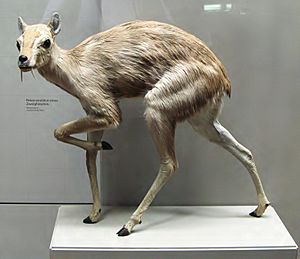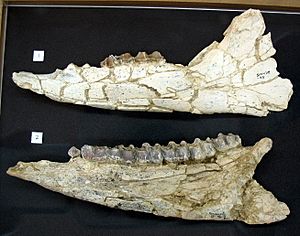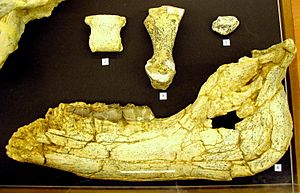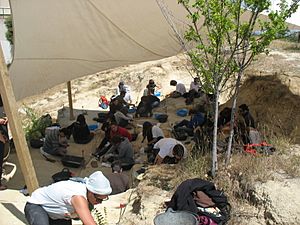Somosaguas fossil site facts for kids
Quick facts for kids Somosaguas paleontological siteStratigraphic range: Middle Aragonian (≈Langhian-Serravallian). |
|
|---|---|
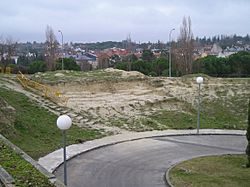
Somosaguas Norte paleontological site, located in the Somosaguas campus of the Complutense University, next to the Faculty of Political Science and Sociology and the Faculty of Social Work.
|
|
| Type | Geological formation |
| Location | |
| Location | Madrid, Spain |
| Coordinates | 40°25′51″N 3°47′19″W / 40.430833°N 3.788556°W |
| Region | Southern Plateau of the Iberian Peninsula |
| Country | Spain |
The Somosaguas fossil site is a special place in Madrid, Spain, where scientists find ancient animal remains. It's located on the Somosaguas campus of the Complutense University in Pozuelo de Alarcón. The fossils here are about 14 million years old. They come from a time called the Middle Miocene epoch, specifically the Aragonian continental stage.
The fossils are found in sediments that were laid down by an alluvial fan. Imagine a giant fan-shaped pile of dirt and rocks carried by water from mountains. The site has two main areas with fossils: Somosaguas Norte and Somosaguas Sur, about 60 meters apart.
A geology student first found bone pieces here in 1989. He reported it to Professor Nieves López Martínez, who confirmed they were fossils. This led to the site becoming an important place for studying Earth's past.
Contents
How the Somosaguas Site Was Discovered
In 1989, a geology student named Francisco Hernández Arteaga was waiting on the Somosaguas campus. He noticed some bone fragments on the ground near the Faculty of Political Science. He didn't report his exciting find until 1996.
First Excavations and Ongoing Work
Once the discovery was reported, experts from the National Museum of Natural Sciences checked the area. They confirmed it was an important paleontological site. The first official fossil dig happened in 1998. Professor Nieves López led a team of students from the Faculty of Geological Sciences of Madrid.
Since then, students and scientists have continued to dig for fossils regularly. Starting in 2000, they set up a special work period each April or May. They also hold open days, workshops, and exhibitions for the public to learn about the site.
The Geology of Somosaguas
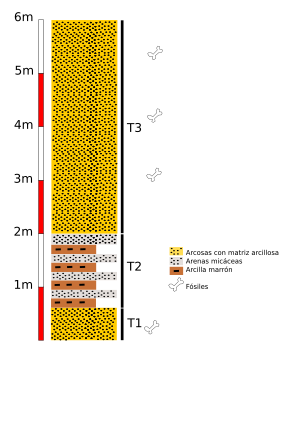
The Somosaguas fossil site sits on layers of rock from the Miocene period. These layers were formed by alluvial fans. These fans were created when water carried eroded pieces of granite and other rocks from the nearby Central System mountains.
The sediments at the site are about 6 meters thick. They are mostly made of sandy rocks called arkoses, mixed with clay and rock fragments. There are also layers of brown clays and sandy areas with mica. Scientists divide these sediments into three main sections:
- Section 1 (T1): This is the bottom layer, about 0.5 meters thick. It's made of arkoses with clay. Many tiny and large vertebrate fossils are found in this section at the Somosaguas Sur site.
- Section 2 (T2): This middle section is up to 1.5 meters thick. It has alternating layers of sandy and clayey materials.
- Section 3 (T3): This is the top layer, more than 3 meters thick. It's also made of arkoses with clay. The larger animal fossils from Somosaguas Norte are found here.
Amazing Fossils Found at Somosaguas
The Somosaguas Sur site is famous for its many tiny mammal fossils. For example, over 400 fossil teeth were found in just 50 kg of sediment! These tiny fossils help scientists figure out the exact age of the site.
Small Mammals and Reptiles
Scientists have identified many different groups of animals from the Somosaguas Sur site. These include:
- Dormice (Gliridae): Like Microdyromys koenigswaldi and Armantomys tricristatus.
- Squirrels (Sciuridae): Such as Heteroxerus grivensis.
- Hamsters and Voles (Cricetidae): Including Megacricetodon collongensis and Democricetodon darocensis.
- Insectivores (Insectivora): Like Miosorex grivensis.
- Rabbits and Hares (Lagomorpha): Such as Lagopsis penai.
- Reptiles (Reptilia): Including ancient turtles (Chelonia) and lizards.
Large Mammals and Other Animals
The Somosaguas Norte site mainly has fossils of larger animals, though some small ones are also found.
- Mastodons: Remains of the huge Gomphotherium angustidens have been found. These were ancient relatives of elephants.
- Rhinoceroses: Fossils of Alicornops and Prosantorhinus douvillei show that rhinos once roamed here.
- Horses: Ancient horses like Anchitherium are also present.
- Ruminants: These are animals that chew their cud, like deer and antelopes. Examples include Heteroprox (a type of deer), Micromeryx (a small musk deer), and Tethytragus (a type of ancient cow).
- Pigs: A type of ancient pig called Conohyus has been identified.
- Carnivores: Fossils of ancient meat-eaters like Hemicyon, Amphicyon, and Pseudaelurus (an early cat) have been recovered.
- Birds and Turtles: Bones from these animals also tell us about the ancient environment.
What Fossils Tell Us About the Past
Scientists study the fossils and the way they are preserved to learn about the past. This study is called taphonomy. At Somosaguas Norte, they found many small bone fragments. This suggests the bones went through a lot of weathering, like being exposed to wind and water. Some bones were very fragile, while others were well-preserved.
Clues from Bones and Climate
- Bone Changes: The bones show signs of being worn down and having their minerals replaced. This tells scientists about the processes that happened to the bones after the animals died.
- Climate Clues: By studying the chemical makeup of the fossils, scientists learned that the climate was getting cooler and drier around 14 million years ago. The temperature dropped about 6 degrees C. This matches a global cooling event when the polar ice cap in Antarctica grew larger.
- Dry Seasons: The type of clay in the sediments also shows there were very long dry seasons.
- Diet of Ancient Animals: By looking at the Ba/Ca ratio in tooth enamel, scientists can guess what the animals ate. For example, ancient horses like Anchitherium ate more grassy plants than mastodons like Gomphotherium. The ancient pig Conohyus likely ate a mix of plants and other things.
How Many Animals Were There?
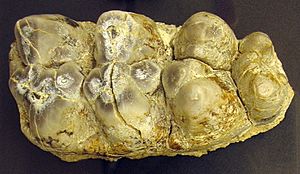
Scientists have counted the different types of fossils found between 1998 and 2006. They found that about 47% were from large animals and 53% were from small animals.
Among the large animals:
- Ruminants (like deer and antelopes) made up about 14% of the fossils.
- The ancient horse Anchitherium was about 12.7%.
- The mastodon Gomphotherium angustidens was about 11%.
- Carnivores and the pig Conohyus simorrensis were each about 3%.
- The rhinoceros Prosantorhinus douvillei was about 2.6%.
The most common small animal fossil was Megacricetodon collongensis, a type of hamster, making up 24% of all fossils! Other common small animals included different types of hamsters, dormice, squirrels, and rabbits.
See also
 In Spanish: Yacimiento paleontológico de Somosaguas para niños
In Spanish: Yacimiento paleontológico de Somosaguas para niños
- List of fossil sites


